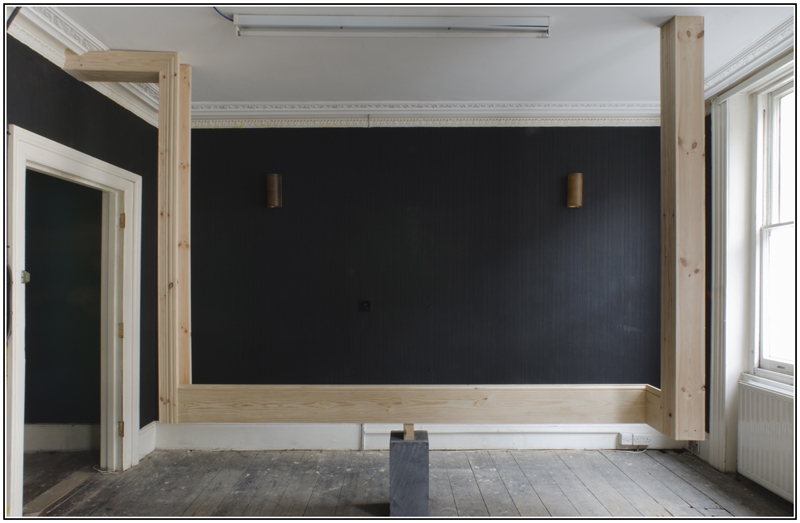A doorframe hangs from the ceiling in a dilapidated room. Its wooden jambs dangle like the swinging legs of a suicide victim. The scene is awkward and not a little depressing. It has the same feeling of domesticity-gone-wrong as does a crime scene. Except here it’s the house itself that seems to have ended it all.
It’s part of the first show by my former colleague Sean Griffiths (My Dreams of Levitation, 2014, Room Artspace, London), with whom I share a long history as a codirector of the architecture (and other things) office FAT. During the 20-odd years of FAT’s practice, the studio shifted from its origins – typical mid-1990s mode – as a cross-disciplinary practice thriving on the hazy boundary between art and architecture, to something approaching the architectural mainstream. We closed the office last year, going out on a high by curating the British Pavilion at the Venice Architecture Biennale and designing a house with Grayson Perry.
It turned out that our original hunch about an art/architecture practice was both exactly right and totally wrong. Right in the sense that architecture, design and fine art have, in certain circumstances, merged. This has brought together alliances of artists, architects, engineers and mayors to produce a new kind of practice: the kind that creates huge, spectacular things performing at an urban scale. Things like Anish Kapoor’s Cloud Gate (2006) in Chicago’s Millennium Park or London’s proposed Garden Bridge by Heatherwick Studio. Along with this we could bag up the headline-stealing architecture that comes out of studios such as those fronted by Zaha Hadid and Frank Gehry. These are projects that are about cities jostling for pole position. We could think of them as a hollowed-out form of practice that has jettisoned any claims to wider disciplinary concerns in the pursuit of global spectacle.
Architecture’s risk aversion became so endemic that it’s little wonder so much new building is anaemic and repetitive to the point that an architecture office is the worst place to be if you want to think about architecture
But while this ‘exceptional’ kind of project has emerged, the rest of the architectural world ‘got small’, as Norma Desmond might have said. That’s to say, architecture’s risk aversion became so endemic that it’s little wonder so much new building is anaemic and repetitive to the point that an architecture office is the worst place to be if you want to think about architecture.
This extreme separation between glittering spectacle and grinding mediocrity leaves the real job – of giving places identity, of creating fulfilling social scenarios, of making engaged and meaningful urban propositions – sadly void. The main part of Griffiths’s installation is a three-dimensional offset of a room constructed within the very same room. The usual trimmings of skirting board, window frame and cornice have been cut loose from the walls they normally anchor and instead float within the space. These traditional strips of domesticated timber have been assembled like a glitchy wireframe-model forming a spatial double-exposure of the room. The doorways become congested by multiple doorframes that pass through their openings, windows become obscured by other versions of themselves suspended in front. Through its jogged offset, the space of the room that normally remains as background to the life that happens within it is made visible and legible. It makes for a very unheimlich kind of semidetaching, where ordinary domestic space is haunted by a ghost of itself.
So is Griffiths’s installation an architectural suicide note? Is he pronouncing architecture’s corpse dead on arrival?
There are many references here. There are shades of Gordon Matta-Clark’s architectural interventions, of Dan Graham’s weird internalised complexities of space. There are moments of architecture too: of Frank Gehry’s early sawn-and-nailgunned Home Depot experiments, of Peter Eisenman’s indexical method and of Venturi and Scott Brown’s Franklin Court ‘ghost house’.
Maybe death isn’t a bad thing. In dying, could architecture be reincarnated as art? Could the architect reborn as an artist imagine a new kind of practice? Maybe, Griffiths is saying, it’s easier to make architecture by approaching it through fine art. Maybe, freed from the yoke of professionalism, something more architectural can emerge. Maybe you have to kill what you love.
This is art about the idea of architecture, and within it are suggestions of how becoming an ex-architect might be a way of defining a new role in the making of space and cities, and how deprofessionalisation might be way for architecture to get its real mojo back.
See here to read more by Sam Jacob
This article was first published in the March 2015 issue.
